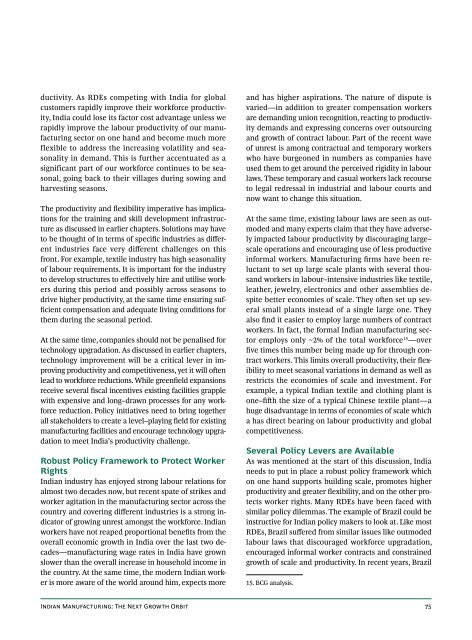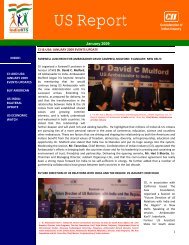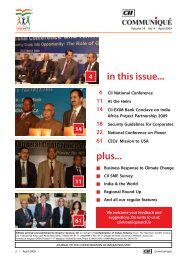A4 Report Template - CII
A4 Report Template - CII
A4 Report Template - CII
You also want an ePaper? Increase the reach of your titles
YUMPU automatically turns print PDFs into web optimized ePapers that Google loves.
ductivity. As RDEs competing with India for globalcustomers rapidly improve their workforce productivity,India could lose its factor cost advantage unless werapidly improve the labour productivity of our manufacturingsector on one hand and become much moreflexible to address the increasing volatility and seasonalityin demand. This is further accentuated as asignificant part of our workforce continues to be seasonal,going back to their villages during sowing andharvesting seasons.The productivity and flexibility imperative has implicationsfor the training and skill development infrastructureas discussed in earlier chapters. Solutions may haveto be thought of in terms of specific industries as differentindustries face very different challenges on thisfront. For example, textile industry has high seasonalityof labour requirements. It is important for the industryto develop structures to effectively hire and utilise workersduring this period and possibly across seasons todrive higher productivity, at the same time ensuring sufficientcompensation and adequate living conditions forthem during the seasonal period.At the same time, companies should not be penalised fortechnology upgradation. As discussed in earlier chapters,technology improvement will be a critical lever in improvingproductivity and competitiveness, yet it will oftenlead to workforce reductions. While greenfield expansionsreceive several fiscal incentives existing facilities grapplewith expensive and long–drawn processes for any workforcereduction. Policy initiatives need to bring togetherall stakeholders to create a level–playing field for existingmanufacturing facilities and encourage technology upgradationto meet India’s productivity challenge.Robust Policy Framework to Protect WorkerRightsIndian industry has enjoyed strong labour relations foralmost two decades now, but recent spate of strikes andworker agitation in the manufacturing sector across thecountry and covering different industries is a strong indicatorof growing unrest amongst the workforce. Indianworkers have not reaped proportional benefits from theoverall economic growth in India over the last two decades—manufacturingwage rates in India have grownslower than the overall increase in household income inthe country. At the same time, the modern Indian workeris more aware of the world around him, expects moreand has higher aspirations. The nature of dispute isvaried—in addition to greater compensation workersare demanding union recognition, reacting to productivitydemands and expressing concerns over outsourcingand growth of contract labour. Part of the recent waveof unrest is among contractual and temporary workerswho have burgeoned in numbers as companies haveused them to get around the perceived rigidity in labourlaws. These temporary and casual workers lack recourseto legal redressal in industrial and labour courts andnow want to change this situation.At the same time, existing labour laws are seen as outmodedand many experts claim that they have adverselyimpacted labour productivity by discouraging large–scale operations and encouraging use of less productiveinformal workers. Manufacturing firms have been reluctantto set up large scale plants with several thousandworkers in labour–intensive industries like textile,leather, jewelry, electronics and other assemblies despitebetter economies of scale. They often set up severalsmall plants instead of a single large one. Theyalso find it easier to employ large numbers of contractworkers. In fact, the formal Indian manufacturing sectoremploys only ~2% of the total workforce 15 —overfive times this number being made up for through contractworkers. This limits overall productivity, their flexibilityto meet seasonal variations in demand as well asrestricts the economies of scale and investment. Forexample, a typical Indian textile and clothing plant isone–fifth the size of a typical Chinese textile plant—ahuge disadvantage in terms of economies of scale whicha has direct bearing on labour productivity and globalcompetitiveness.Several Policy Levers are AvailableAs was mentioned at the start of this discussion, Indianeeds to put in place a robust policy framework whichon one hand supports building scale, promotes higherproductivity and greater flexibility, and on the other protectsworker rights. Many RDEs have been faced withsimilar policy dilemmas. The example of Brazil could beinstructive for Indian policy makers to look at. Like mostRDEs, Brazil suffered from similar issues like outmodedlabour laws that discouraged workforce upgradation,encouraged informal worker contracts and constrainedgrowth of scale and productivity. In recent years, Brazil15. BCG analysis.Indian Manufacturing: The Next Growth Orbit 75
















